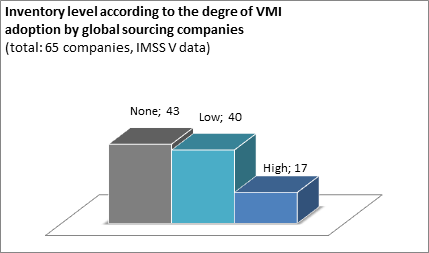Archive
Vendor Managed Inventory for Global Sourcing Companies
 By Ruggero Golini and Martina Lozza, Università degli Studi di Bergamo
By Ruggero Golini and Martina Lozza, Università degli Studi di BergamoVendor Managed Inventory (VMI) is an operating model in which the supplier delivers its good to the customer but the actual sale is postponed after the actual use/sale by the customer. The supplier, which can be a manufacturer, reseller or a distributor monitors the customer’s inventory levels and makes inventory replenishment decisions regarding order quantities, shipping and timing.
The advantages of implementing VMI program can be summarized as: reduced inventory costs, better response to market changes, reduction in demand uncertainty and more flexibility in production planning and distribution.
Recentely, we focused on how VMI can support global sourcing.
As we know, there are several reasons for adopting global sourcing such as lower prices, quality technology access, access to new markets, shorter product development and life cycles, comparative advantage. However, the adoption of global sourcing often leads to some problems such as increase of inventory level because of the average inventory level depends on the supply lead time and variability, which get higher when the distance between supplier and buyer increases.
According to our analysis, the implementation of VMI can be a very effective way to reduce the inventory level for global sourcing companies.
We used the fifth edition of the International Manufacturing Strategy Survey (www.manufacturingstrategy.net) and we picked the companies with a relevant adoption of global sourcing (more than 30% of their purchases comes from outside the continent). We can see that 75% of the companies uses VMI with suppliers but only 26% declare to have a high and spread adoption.

The next histogram shows the average level of inventory (measured in days of production carried in the material and components inventory) and it is evident that when the VMI is highly implemented the inventory level decreases significantly.

Obviously implementing VMI when suppliers are far away can be difficult due to geographical and linguistic distance and the necessary conditions have to be met. However the positive impact VMI is remarkable and, especially when holding inventories is costly (like in these days), global sourcing companies should definitely consider VMI into their supply chain investments portfolio.
Bibliography
Danese, P. 2006. The extended VMI for coordinating the whole supply network. Journal of Manufacturing Technology Management 17 (7), 888–907.
Disney, S.M., Towill, D.R. 2003. The effect of vendor managed inventory (VMI) dynamics on Bullwhip Effect in supply chains. International Journal of Production Economics, Volume 85, Issue 2, pp. 199-215.
Golini, R., Kalchschmidt, M., 2011. Moderating the impact of global sourcing on inventories through supply chain management. International Journal of Production Economics, 133, 86-94.
